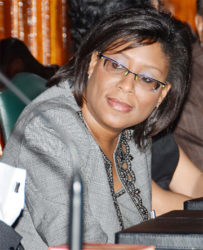As day three of the 2017 National Budget debate continued yesterday, Minister of Public Telecommunications, Cathy Hughes defended the application of Value Added Tax (VAT) to internet service, saying the tax would provide the monies needed to fund the Government’s Infor-mation and Communication Technology (ICT) programmes.
It was her contention that while the VAT on data has received harsh criticism, it is a necessary revenue stream, given the range of transformational measures the Ministry has planned for the development of ICT in Guyana.

And with the expectation that the new liberalized environment will spur competition among service providers, Hughes said she anticipates a reduction in the high cost of internet access for the benefit of all Guyanese.
The Minister, in her address to the National Assembly, also took the opportunity to elaborate on the allocation of $1.58 billion for E – Governance initiatives expected to be conducted in the coming year.
Of the $1.58 billion allocated, an estimated $114 million has been earmarked for the provision of public internet access, at over 600 Government buildings across the country.
These Public Internet Access Points (PIAPs), she said will increase the opportunities, and channels through which thousands of Guyanese will have access to online resources as part of Government’s aim to reduce the digital divide, and increase digital interconnection and association with the Government.
Key to this initiative, Hughes noted, is the transformation of strategically located post offices into comfortable, refurbished Information Communications Technology (ICT) hubs, which will provide opportunities for citizens to visit these hubs, to access the internet free of charge, to receive Government services.
Of particular interest to the Ministry, is the establishment of community ICT hubs at those post offices within reach of the E-Government Network, that were previously in digitally excluded communities such as Lethem, Linden, Bartica, Mahdia, Mabaruma, and Port Kaituma.
She also spoke of the estimated $90 million that has been allocated for the provision of ICT access to the hinterland, as well as the poor and remote communities throughout Guyana.
“We intend to expand the reach of Government services to the hinterland. Community ICT hubs and PIAPs will be established in Masakenari, Annai, Lethem, Waramadong, Paramakatoi, Aishalton, St. Cuthbert’s Mission, Linden, Bartica, Mahdia, Mabaruma, Port Kaituma, and Kwakwani, in addition to at least 24 more pilot communities across Guyana,” Hughes said.
The aim of this initiative, she added, is to improve the livelihoods of persons in those regions, and to reduce the digital divide that exists between the coastland and hinterland, while allowing the Government to leverage local (indigenous) knowledge in the development of Guyana’s natural raw materials, and the promotion and marketing of local products.
A further 30 pilot Community ICT hubs, serving an estimated 60,000 residents, will be established in Regions covered by the E-Government Network (E-GovNet) which spans Regions 2, 3, 4, 5 and 6, while communities in Regions 1,7,8 ,9 and 10 will be considered at the next stage of expansion.
“These hubs would improve residents’ access to information and services, increase knowledge and practices in traditional economic sectors, support education and learning for youths and adults, and build cohesion in communities. An estimated $30 million has been allocated for these pilots, with the wider project expected to come on stream in the latter half of 2017,” the Minister said.
For the maintenance and expansion of the E-GovNet, approximately $435 million has been allocated, and includes $70 million for the expansion of the network to Timehri, Amelia’s Ward, Diamond, and further afield; $50 million for ensuring the cyber security of Government’s network; and $275 million for the maintenance and technical support services required to ensure the continued functionality of the network.
Moreover, $674 million has been allocated towards the provision of connectivity and internet access to the over 140 Government locations already connected to the E-GovNet; and the more than 600 Government locations planned for 2017, the Minister added.
Hughes also highlighted the distribution of over 8000 laptops to teachers across the country, as part of the one laptop per teacher programme.
The goal of this approach is to enhance digital learning and is complemented by government’s initiative to implement high speed internet access in all secondary schools. Teachers all over Guyana now own their own laptops, preloaded with marking schemes, resources for Maths, English and so much more.




